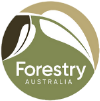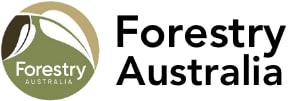
Forestry Australia Position Statements
Forestry Australia, the professional association for forest scientists, forestry professionals and forest growers has prepared a range of balanced science-based positions on important forest policy and forest management issues. The following position statements are the consensus view of Forestry Australia’s members – scientists and professionals who manage, study and care for our forests.
These statements are available for use by Forestry Australia members, policy makers and the broader forestry sector. The two-page position statements provide context, Forestry Australia’s position, supporting notes and further reading on contemporary forest issues. These policy statements will be subject to periodic review. Comments are welcome at any time, will be retained and considered when undertaking the next review.
New statements will be added over coming months.
Ecologically Sustainable Forest Management
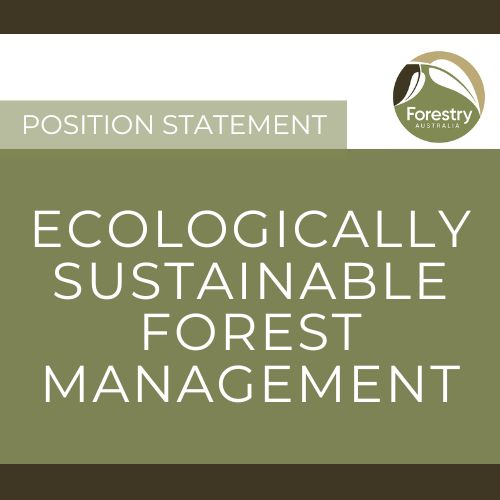
CONTEXT: In Australia, forested landscapes are likely to have been actively and adaptively managed by Aboriginal and Torres Strait Islander peoples for over 60,000 years. The 1992 National Forest Policy Statement established the vision of achieving ecologically sustainable forest management of all of Australia’s forests: public and private native forests and plantations; which requires maintaining ecological processes and biodiversity within forests and optimising the benefits to the community from all forest uses within ecological constraints.
The United Nations Forest Instrument defines sustainable forest management as a dynamic and evolving concept that aims to maintain and enhance the economic, social and environmental values of all types of forests, for the benefit of present and future generations. This requires analysis of data on all forest uses and values to determine a balanced but sustainable management regime for forests. At the national level, Australia uses the international Montréal Process Criteria and Indicators for Sustainable Forest Management to measure how well our forests are being managed. At the local level, production forest managers can demonstrate sustainable forest management through accreditation and regular audits under independent internationally recognised forest certification systems.
Likewise, the managers of protected and conserved forests can become certified under the IUCN Green List Standard thereby recognising that these areas are managed for people and nature in a fair and effective way.
Click HERE to download the statement
Forest Fire Management

CONTEXT: Fire has been part of the Australian environment for millions of years; it is an essential element and can’t be removed without ecological consequences. Aboriginal people developed appropriate fire management practices to maintain their culture and Country. Australia has experienced an increased occurrence of severe bushfires, that result in substantial impacts on life, property, forest biodiversity, water quality and quantity, forest products and uses as well as on the health and resilience of forest ecosystems. Australia’s knowledge and systems of forest fire management are based on decades of bushfire research and lessons from previous bushfire inquiries.
The COAG-endorsed National Bushfire Management Policy Statement for Forests and Rangelands brings this knowledge together to provide appropriate goals and strategies for reducing the occurrence, severity, and impacts of bushfires as well as for enhancing the resilience of forest and rangeland ecosystems.
Click HERE to download the statement
Forest Fire Recovery and Restoration
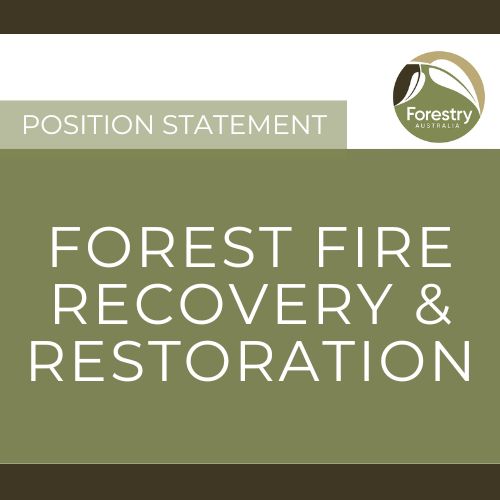
CONTEXT: Severe bushfires often result in adverse impacts on a range of and environmental values as well as on local communities, forest industries and forest uses. While many native Australian forest ecosystems are fire-adapted and reasonably resilient to fire, the increased frequency and intensity of severe bushfires is affecting the resilience and ecological integrity of both fire sensitive and fire tolerant forest ecosystems. In plantations, particularly those of exotic species, the trees are killed by bushfire and require salvage harvesting and replanting. Bushfire recovery and forest restoration programs assist with restoring the health and productivity of forests as well as minimising and addressing the adverse impacts of severe bushfires on forest uses and values.
Click HERE to download the statement
Sustainable Forest Harvesting
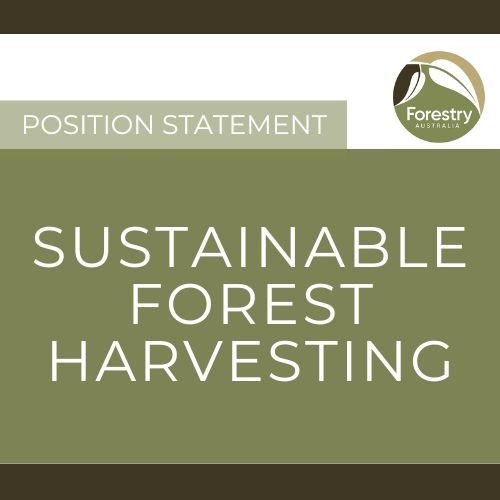
CONTEXT: In Australia, native forests and plantations are harvested and regenerated to provide forest products with multiple flow-on benefits and to meet a range of society’s needs. Australia has a growing balance of trade deficit in forest products. Sustainable forest harvesting is not deforestation, because of the key requirement to regenerate harvested areas. Deforestation occurs when forests are converted to other land uses. Compliance with legislation, regulations and Codes of Practice, the implementation of strategic and operational management plans, and independent third-party forest certification schemes all provide assurance that harvesting practices in Australia are managed sustainably.
Sustainable harvesting practices are those that enable reforestation, take account of social and economic outcomes and are adaptively managed to mitigate risks to the environment. Plantations and native forests provide different types of forest and wood products and therefore both have a role to play and must be managed as part of a holistic forest products supply strategy. Unintended consequences associated with reducing sustainable forest harvesting in Australia include increased reliance on imports and forgoing a range of flow-on benefits to communities and the environment. Different silvicultural techniques can be utilised to support forest health and biodiversity, mitigate risks from fire, pests and diseases and to grow bigger trees quicker, storing more carbon and creating forests that are more resilient.
Click HERE to download the statement
Conservation of Threatened Species
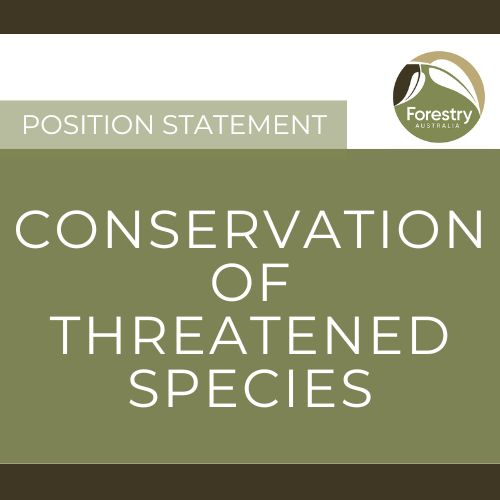
CONTEXT: There is ongoing biodiversity decline occurring across Australia, including in forests. The list of threatened species at risk of extinction continues to grow, as a result of multiple threatening processes including invasive species, land clearing, climate change, and changes in both fire regimes and land management practices. Protected and conserved areas are under-funded and most threatened species have complex habitat needs, which are not yet fully understood. Australia’s spending on conservation programs is disproportionally low and often biased towards high profile species or politically sensitive environments, to the detriment of other species or places where recovery actions could have a higher chance of success. Australia’s tenure-based land management system creates siloes which can limit the effective management of threatened species at the landscape level. Active and adaptive management, informed by research, traditional knowledge and monitoring, is needed to secure threatened species recovery and will have the best chance of success where there is multi-stakeholder involvement and a holistic view of threats and actions over the long-term.
Click HERE to download the statement
Forest Carbon Markets

CONTEXT: Globally, it is well recognised that forests, including avoiding deforestation, play a critical role in helping to mitigate the effects of climate change through carbon capture and storage. While more carbon is stored in older forests than in younger forests, the rate of carbon capture is significantly higher in young actively growing trees. Globally, and across Australia, forests are an important carbon sink, and when appropriately protected and sustainably managed, can absorb more carbon than is emitted from a range of forest management activities. Sustainably harvested wood products are renewable and can act as a long-lived carbon store as well as replace fossil fuel usage as an environmentally friendly energy source.
In Australia, the value of forests in mitigating climate change is recognised through existing and proposed carbon credit markets and emission reduction incentives. To generate Australian carbon credit units (ACCUs), projects can be developed to apply an approved methodology under the ACCU Scheme (formerly the Emissions Reduction Fund (ERF)). Integrity of carbon projects is crucial to the carbon market. Approved methods work to create real and quantifiable levels of greenhouse gas abatement that would not occur without the carbon project. There are opportunities to further develop methodologies and uptake within the forest growing and downstream wood products sectors to leverage the carbon benefits that forests bring.
Click HERE to download the statement
National Forest Policy Statement
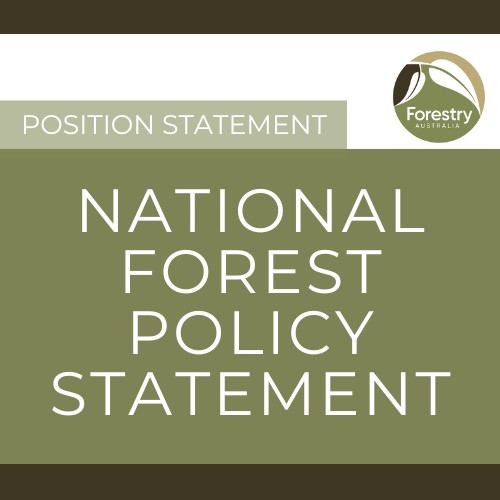
CONTEXT: A national forest policy should contain long-term goals and associated strategies that provide guidance for legislation, the management of nationally important forest values including climate change mitigation and biodiversity conservation, land use and forest management decisions, and investment in the forest sector. The 1992 National Forest Policy Statement (NFPS) has provided the overarching policy framework for cross jurisdictional management of Australia’s public and private forests and the associated forest industries for the past 30 years. However, state government native forest management policies, community expectations, and the proportion of wood products sourced from native forests and plantations have changed over this time, while climate change has presented new issues and opportunities for the forest sector. The 2023 Labor Party national conference agreed to a review of Australia’s NFPS by early 2025. This Position Statement focuses on high-level aspects within the current NFPS, including the Vision and National Goals.
Click HERE to download the statement
Thinning of Native Forests
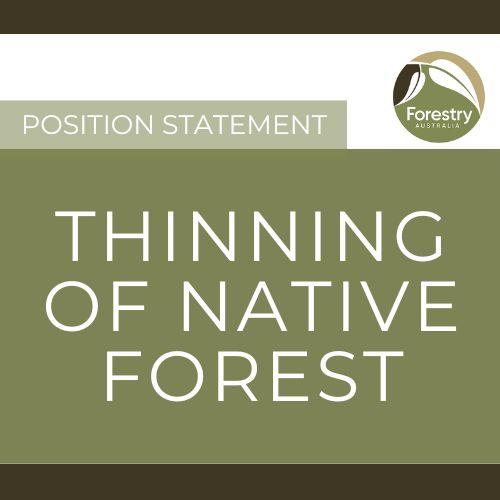
CONTEXT: The health and resilience of many native forests are being compromised by factors such as climate change, pests and diseases, altered or inappropriate land management practices and some land use decisions. Australian forest ecosystems have evolved with periodic droughts and bushfires, but the frequency and intensity of these events is increasing. In many forests, tree density has increased due to removal of active management by Aboriginal and Torres Strait Islander peoples, prolific regeneration following intense bushfires, or sustainable timber harvesting practices in selected areas of State forests. High tree densities can make forests more prone to stress and therefore more vulnerable to negative impacts from drought, insect pests, disease and bushfire. In some forest types, over-crowded stand structures can cause the forest to stop growing; which limits further carbon uptake and storage.
Forest thinning is a silvicultural practice whereby a selective portion of trees are removed across a site to reduce competition for water and nutrients. This allows the retained trees to grow bigger, more quickly, thereby increasing the size of tree trunks and crowns. While thinning has traditionally been undertaken to improve timber yields, there are many other ecological and cultural objectives that can be achieved through thinning. These include enhancing wildlife habitat, increasing water yields in catchments, and restoring open forest structures to facilitate re-introduction of cultural burning practices.
Click HERE to download the statement
Forest Research, Development and Dissemination
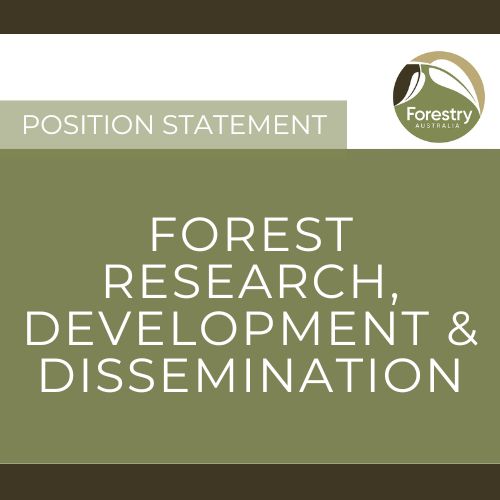
CONTEXT: Ongoing well-directed scientific research into Australian forests, the threats facing them and into their uses, services and values is a fundamentally important part of ecologically sustainable forest management. Likewise, ongoing research and development programs are critical to maintaining the ability of Australia’s forest industries to be internationally competitive in the production of innovative and sustainable forest and wood products. Australia’s forest research capability has and continues to contribute to improved environmental management and livelihoods from forests and tree growing in many developing countries.
Dissemination of the findings of research and development activities, using mechanisms appropriate to the intended users, is vital to facilitate its adoption and achieve the intended social, economic and environmental outcomes and impacts. As forest and wood products research and development provides both public and private benefits, it should be adequately funded by both government and the private sector.
Click HERE to download the statement
